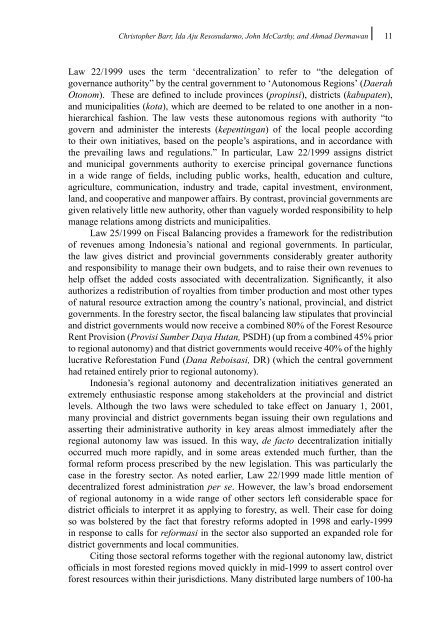Decentralization of Forest Administration in Indonesia, Implications ...
Decentralization of Forest Administration in Indonesia, Implications ...
Decentralization of Forest Administration in Indonesia, Implications ...
Create successful ePaper yourself
Turn your PDF publications into a flip-book with our unique Google optimized e-Paper software.
Christopher Barr, Ida Aju Resosudarmo, John McCarthy, and Ahmad Dermawan 11<br />
Law 22/1999 uses the term ‘decentralization’ to refer to “the delegation <strong>of</strong><br />
governance authority” by the central government to ‘Autonomous Regions’ (Daerah<br />
Otonom). These are def<strong>in</strong>ed to <strong>in</strong>clude prov<strong>in</strong>ces (prop<strong>in</strong>si), districts (kabupaten),<br />
and municipalities (kota), which are deemed to be related to one another <strong>in</strong> a nonhierarchical<br />
fashion. The law vests these autonomous regions with authority “to<br />
govern and adm<strong>in</strong>ister the <strong>in</strong>terests (kepent<strong>in</strong>gan) <strong>of</strong> the local people accord<strong>in</strong>g<br />
to their own <strong>in</strong>itiatives, based on the people’s aspirations, and <strong>in</strong> accordance with<br />
the prevail<strong>in</strong>g laws and regulations.” In particular, Law 22/1999 assigns district<br />
and municipal governments authority to exercise pr<strong>in</strong>cipal governance functions<br />
<strong>in</strong> a wide range <strong>of</strong> fields, <strong>in</strong>clud<strong>in</strong>g public works, health, education and culture,<br />
agriculture, communication, <strong>in</strong>dustry and trade, capital <strong>in</strong>vestment, environment,<br />
land, and cooperative and manpower affairs. By contrast, prov<strong>in</strong>cial governments are<br />
given relatively little new authority, other than vaguely worded responsibility to help<br />
manage relations among districts and municipalities.<br />
Law 25/1999 on Fiscal Balanc<strong>in</strong>g provides a framework for the redistribution<br />
<strong>of</strong> revenues among <strong>Indonesia</strong>’s national and regional governments. In particular,<br />
the law gives district and prov<strong>in</strong>cial governments considerably greater authority<br />
and responsibility to manage their own budgets, and to raise their own revenues to<br />
help <strong>of</strong>fset the added costs associated with decentralization. Significantly, it also<br />
authorizes a redistribution <strong>of</strong> royalties from timber production and most other types<br />
<strong>of</strong> natural resource extraction among the country’s national, prov<strong>in</strong>cial, and district<br />
governments. In the forestry sector, the fiscal balanc<strong>in</strong>g law stipulates that prov<strong>in</strong>cial<br />
and district governments would now receive a comb<strong>in</strong>ed 80% <strong>of</strong> the <strong>Forest</strong> Resource<br />
Rent Provision (Provisi Sumber Daya Hutan, PSDH) (up from a comb<strong>in</strong>ed 45% prior<br />
to regional autonomy) and that district governments would receive 40% <strong>of</strong> the highly<br />
lucrative Reforestation Fund (Dana Reboisasi, DR) (which the central government<br />
had reta<strong>in</strong>ed entirely prior to regional autonomy).<br />
<strong>Indonesia</strong>’s regional autonomy and decentralization <strong>in</strong>itiatives generated an<br />
extremely enthusiastic response among stakeholders at the prov<strong>in</strong>cial and district<br />
levels. Although the two laws were scheduled to take effect on January 1, 2001,<br />
many prov<strong>in</strong>cial and district governments began issu<strong>in</strong>g their own regulations and<br />
assert<strong>in</strong>g their adm<strong>in</strong>istrative authority <strong>in</strong> key areas almost immediately after the<br />
regional autonomy law was issued. In this way, de facto decentralization <strong>in</strong>itially<br />
occurred much more rapidly, and <strong>in</strong> some areas extended much further, than the<br />
formal reform process prescribed by the new legislation. This was particularly the<br />
case <strong>in</strong> the forestry sector. As noted earlier, Law 22/1999 made little mention <strong>of</strong><br />
decentralized forest adm<strong>in</strong>istration per se. However, the law’s broad endorsement<br />
<strong>of</strong> regional autonomy <strong>in</strong> a wide range <strong>of</strong> other sectors left considerable space for<br />
district <strong>of</strong>ficials to <strong>in</strong>terpret it as apply<strong>in</strong>g to forestry, as well. Their case for do<strong>in</strong>g<br />
so was bolstered by the fact that forestry reforms adopted <strong>in</strong> 1998 and early-1999<br />
<strong>in</strong> response to calls for reformasi <strong>in</strong> the sector also supported an expanded role for<br />
district governments and local communities.<br />
Cit<strong>in</strong>g those sectoral reforms together with the regional autonomy law, district<br />
<strong>of</strong>ficials <strong>in</strong> most forested regions moved quickly <strong>in</strong> mid-1999 to assert control over<br />
forest resources with<strong>in</strong> their jurisdictions. Many distributed large numbers <strong>of</strong> 100-ha

















